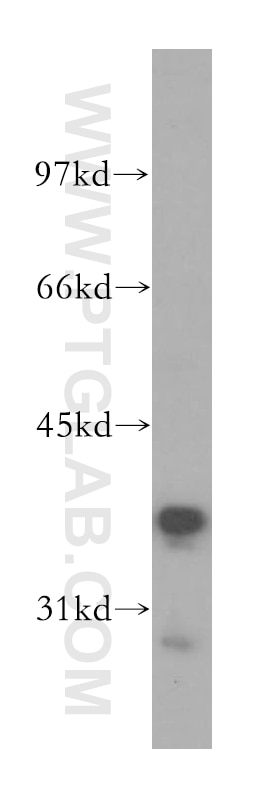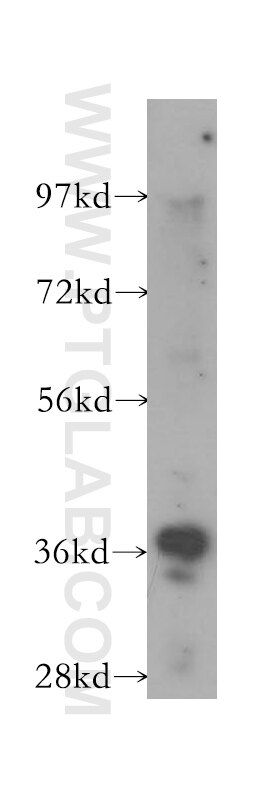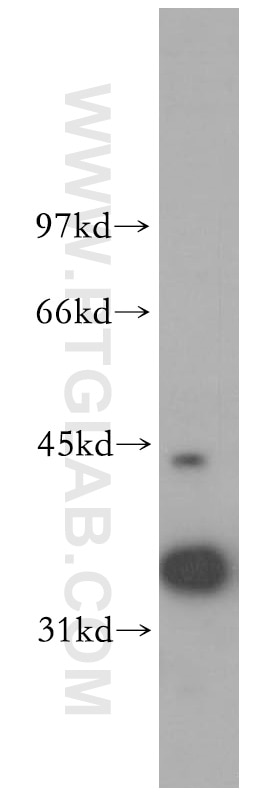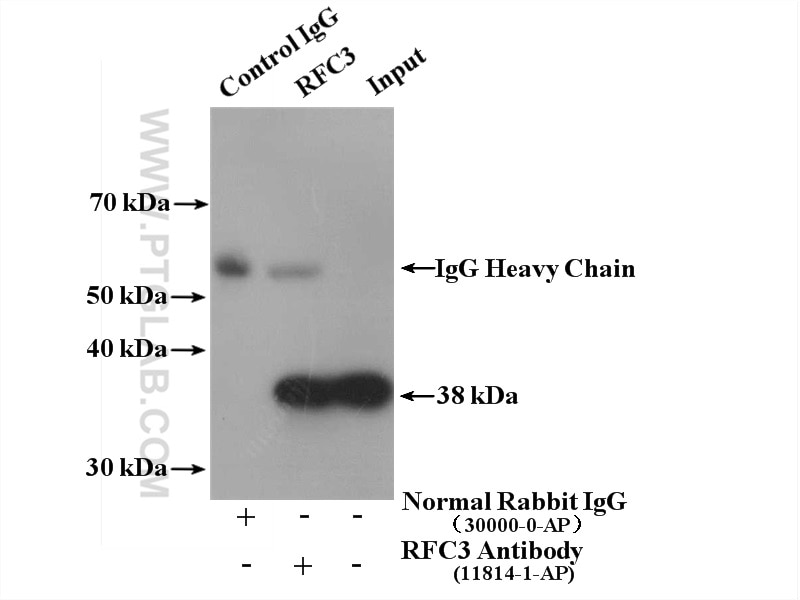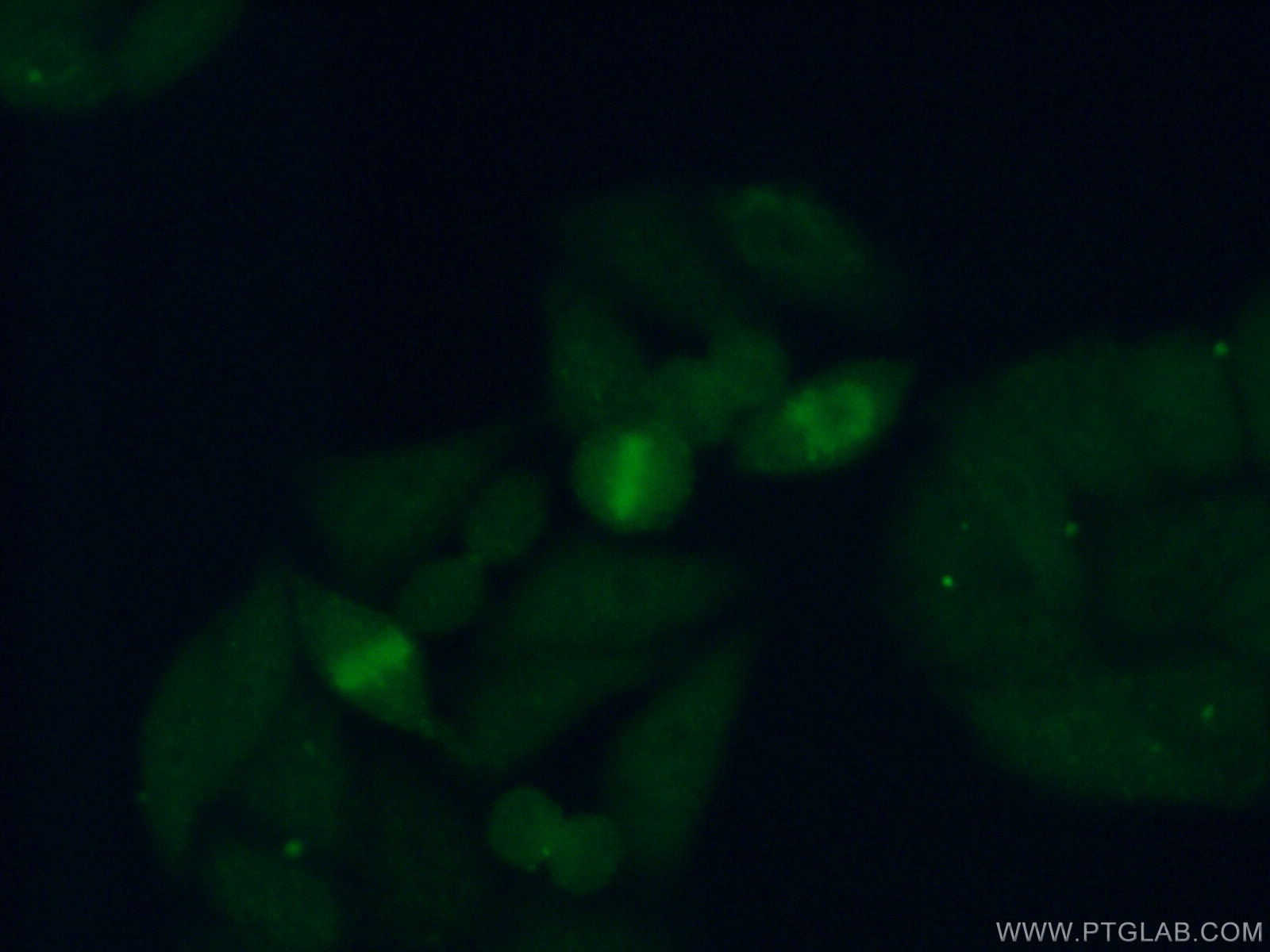- Phare
- Validé par KD/KO
Anticorps Polyclonal de lapin anti-RFC3
RFC3 Polyclonal Antibody for WB, IP, IF, ELISA
Hôte / Isotype
Lapin / IgG
Réactivité testée
Humain, rat, souris
Applications
WB, IF/ICC, IP, CoIP, ELISA
Conjugaison
Non conjugué
N° de cat : 11814-1-AP
Synonymes
Galerie de données de validation
Applications testées
| Résultats positifs en WB | tissu hépatique humain, cellules HeLa, tissu cardiaque humain |
| Résultats positifs en IP | cellules HeLa, |
| Résultats positifs en IF/ICC | cellules HepG2 |
Dilution recommandée
| Application | Dilution |
|---|---|
| Western Blot (WB) | WB : 1:500-1:3000 |
| Immunoprécipitation (IP) | IP : 0.5-4.0 ug for 1.0-3.0 mg of total protein lysate |
| Immunofluorescence (IF)/ICC | IF/ICC : 1:50-1:500 |
| It is recommended that this reagent should be titrated in each testing system to obtain optimal results. | |
| Sample-dependent, check data in validation data gallery | |
Applications publiées
| KD/KO | See 1 publications below |
| WB | See 3 publications below |
| CoIP | See 1 publications below |
Informations sur le produit
11814-1-AP cible RFC3 dans les applications de WB, IF/ICC, IP, CoIP, ELISA et montre une réactivité avec des échantillons Humain, rat, souris
| Réactivité | Humain, rat, souris |
| Réactivité citée | Humain, souris |
| Hôte / Isotype | Lapin / IgG |
| Clonalité | Polyclonal |
| Type | Anticorps |
| Immunogène | RFC3 Protéine recombinante Ag2269 |
| Nom complet | replication factor C (activator 1) 3, 38kDa |
| Masse moléculaire calculée | 40 aa, 6 kDa |
| Poids moléculaire observé | 38 kDa |
| Numéro d’acquisition GenBank | BC000149 |
| Symbole du gène | RFC3 |
| Identification du gène (NCBI) | 5983 |
| Conjugaison | Non conjugué |
| Forme | Liquide |
| Méthode de purification | Purification par affinité contre l'antigène |
| Tampon de stockage | PBS avec azoture de sodium à 0,02 % et glycérol à 50 % pH 7,3 |
| Conditions de stockage | Stocker à -20°C. Stable pendant un an après l'expédition. L'aliquotage n'est pas nécessaire pour le stockage à -20oC Les 20ul contiennent 0,1% de BSA. |
Informations générales
RFC3, also known as RFC38, is a 356 amino acid protein, which localizes in nucleus. Replication factor C (RFC) is a component of the eukaryotic DNA polymerase . In all eukaryotic cell cycles, it is essential for DNA duplication, DNA injury repair and checkpoint control. RFC consists of five subunits (RFC1-5). The interrelationships between RFC2, RFC3 and the c-MYC oncogene (transcription factor) can induce cell division and proliferation. RFC3 is associated with liver, breast, esophageal and ovarian cancer, and serves a critical role in cellular proliferation, invasion and metastasis. RFC3 exists two isoforms with molecular weight of 34 kDa and 38-40 kDa.
Protocole
| Product Specific Protocols | |
|---|---|
| WB protocol for RFC3 antibody 11814-1-AP | Download protocol |
| IF protocol for RFC3 antibody 11814-1-AP | Download protocol |
| IP protocol for RFC3 antibody 11814-1-AP | Download protocol |
| Standard Protocols | |
|---|---|
| Click here to view our Standard Protocols |
Publications
| Species | Application | Title |
|---|---|---|
Virol J IRF2 inhibits ZIKV replication by promoting FAM111A expression to enhance the host restriction effect of RFC3.
| ||
Cell Rep Cyclin N-Terminal Domain-Containing-1 Coordinates Meiotic Crossover Formation with Cell-Cycle Progression in a Cyclin-Independent Manner. | ||
Exp Ther Med RFC3 drives the proliferation, migration, invasion and angiogenesis of colorectal cancer cells by binding KIF14 |
